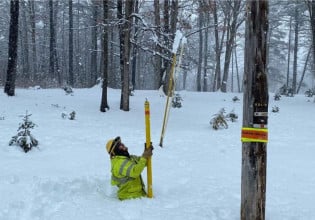Tesla Megapacks to Power One of World’s Largest Energy Storage Facilities
Developers of a 250 MW energy storage project in Canada tapped Tesla as the battery supplier for one of the largest sites of its kind worldwide.
Partners in developing a major energy storage project in Canada recently finalized a deal with Tesla to supply its shipping container-sized Megapack system to power the 250-megawatt (MW) facility. One of the largest worldwide and the largest of its kind in Canada, the Oneida Energy Storage project will provide one gigawatt-hour (GWh) of energy storage capacity to the local grid in southern Ontario.

Developers of the upcoming Oneida Energy Storage project in Ontario, Canada, recently secured a battery supply deal for Tesla’s Megapack system. Image used courtesy of Oneida Energy Storage Limited Partnership
The project is headed by Oneida Energy Storage LP, a joint venture between Toronto-based energy storage developer NRStor and the Six Nations of the Grand River Development Corporation (SNGRDC), a trust that organizes the business activities of the largest First Nations reserve by population, with more than 25,000 registered members. The site is on a 10-acre plot about 10.5 miles from Six Nations boundaries.
Energy Storage Systems
To build the facility, Oneida Energy Storage secured a $141 million deal with Vancouver-headquartered construction firm Aecon Group, which also serves as an equity partner. Its work will include designing the facility, procuring equipment, and installing foundations, underground cables, electrical houses, battery transformers, and switchgear. It will also build a high-voltage substation and run commissioning activities. Construction should begin in the second quarter of this year and finish in 2025.
Earlier this month, NRStor and SNGRDC finalized a 20-year energy storage facility agreement with Ontario’s Independent Electricity System Operator, following a directive from Ontario Minister of Energy Todd Smith. Toronto-based clean energy producer Northland Power confirmed that it acquired a majority interest in the project in late-2022.
Energy storage systems are crucial for the global transition to renewable energy, allowing utilities to manage the natural volatility of wind and solar resources and power the grid when energy demand is highest.
According to its developers, the Oneida Energy Storage project will help Ontario reduce greenhouse gas emissions by 4.1 million metric tons throughout its 20-year lifetime—roughly the same as removing 40,000 cars from the roads yearly. At the same time, ratepayers are expected to receive up to $760 million in net savings.
Oneida Energy Storage Project
The Oneida Energy Storage project has been in the works since 2018. It’s partially financed by a $170 million investment from the Canada Infrastructure Bank, which signed a memorandum of understanding in January 2021. It also received $50 million from Natural Resources Canada’s Smart Renewables and Electrification Pathways program.
The facility is the latest of several projects in NRStor’s portfolio, including a 2 MW flywheel energy storage project (commissioned in 2014), a 4 MW lithium-ion battery storage facility (also since 2014), a 5 MW hybrid battery/flywheel storage facility (launched in 2020), and a 1.75 MW compressed-air energy storage project (also 2020).
This isn’t NRStor’s first time working with Tesla. In 2015, a joint venture between NRStor and grid software provider Opus One Solutions partnered with the Austin-based electric car giant on a pilot program to deploy more than 200 installations of its 1 MW/2.5 MWh Powerwall stationary battery across Canada.
That was before Tesla launched the Megapack in 2019, introducing a higher-capacity unit designed for utility-scale use with over 3 MWh of energy storage—enough to power 3,600 homes for an hour. More specifically, the two-hour duration provides 1.9 MW of power and 3.8 MWh of energy, while the four-hour version supplies 970 kilowatts and 3.9 MWh.
Growing Demand for Megapacks
Megapacks are used across several sites worldwide, with more than 5 GWh deployed. Among the largest is the 350 MW Victoria Big Battery project, a 212-unit system serving backup protection to the Australian state of Victoria. Another is the 100 MW Gambit Energy Storage Park, an 81-unit system in Angleton, Texas. One of Europe’s largest battery energy storage plants launched in Belgium last year with 40 Megapack units, totaling 50 MW of power and 100 MWh of capacity.

Tesla’s shipping container-sized Megapack system. Image used courtesy of Tesla
Consistent with the broader market, demand for Tesla’s energy storage products is skyrocketing. In its fourth-quarter 2022 earnings deck last month, the company said its storage deployments grew 152% year-over-year to 6.5 GWh in 2022—its highest-ever figure. However, Tesla’s storage demand still exceeds its supply capacity, prompting the company to increase production at its 40 GWh Megapack factory in California.

Tesla’s fourth-quarter 2022 earnings deck shows the company’s energy storage deployment growth. Image used courtesy of Tesla
Exactly how many Megapack units Tesla is producing to meet demand is still being determined. In September, CNBC reported on an internal meeting in which the company’s energy executive said it could produce 42 Megapack batteries per week. It was on track to build 442 in the third quarter of 2022, up 85% from the previous three months.
The timeline for new deliveries is also unclear, as Tesla’s website indicates that customers can place orders with a delivery date of Q4 2024 at the earliest.
While the financial terms of Oneida’s deal with Tesla were not disclosed, Tesla’s website shows an order for a single Megapack to be delivered to California in late 2024 would cost $1.9 million, not including taxes and installation.






